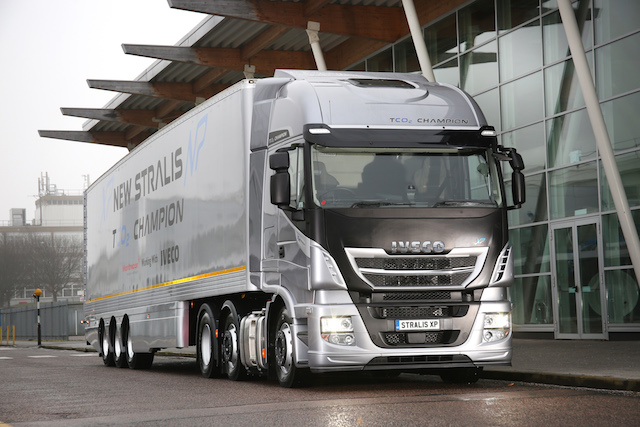Iveco is positioning itself to make the most of opportunities arising from the recent Brexit vote, according to the company’s UK & ROI managing director, Stuart Webster.
He said despite business uncertainly, the Italian manufacturer was focusing on being adaptable and ready to move fast to seize emerging trends.
“For me, 2016 was a year of two halves,” Webster told Trucking at the recent State of the Nation address at the manufacturer’s HQ in Basildon.
“This time 12 months ago, the Referendum didn’t even exist. No-one had thought of the word ‘Brexit’ – and the idea that the country would vote for change was not widely foreseen. The economy was strong. The market has been consistently dynamic for the last five years: confidence had returned, the deficit was heading south, and stability was once again the name of the game.”
He said after two years where new commercial vehicle demand had been skewed by the effects of legislation and Euro 6, 2015 had returned to what the industry considered more ‘normal’ levels, with around 45,000 units registered.
But although trucks entered 2016 on a positive note, the market did present some interesting fluctuations.
“The strength of truck demand in recent years has been all about tractors. Demand had shot through the roof – 2015 had been the second highest tractor market ever; some might say the highest real market ever, given the previous record in 2013 had been created solely by pre-Euro 6 buying in the belief Euro 6 was going to hurt fuel economy and cost a lot more money.”
This focus on tractors over the 2013 to 2015 period, said Webster, created a “glut” in the market place.
“The world was awash with young, good-looking tractors – with a used market that was struggling to absorb them all,” he said. “So demand began to dip quite significantly as we entered 2016 – with the focus switching instead to two- and three-axle rigids.”
These, he said, had been something of a “poor relation” in the past few years. There had been interest, particularly at the heavier end where those whose operations depended on rigids had moved up in weight towards 6x2s, but sales of lighter-weight rigids, particularly at 7.5 tonnes, had remained flat or on a downward trajectory.
“That changed as we moved into 2016,” he said. “While tractors were dipping and on the way down, light- to medium-weight rigid numbers were on the increase, up 25 per cent from 6 to 16 tonnes – while 18-tonners were up a similar 17 per cent.”
This, he reckoned, was because operators were refocusing on distribution rigids after a period when they’d had to play second fiddle to tractors, supported by strong residual values.
“So taken overall, trucks had a good first half of the year: up 11.3 per cent above six tonnes, giving us an annualised expectation of some 48 to 49,000 units for the year.”
However, when Brexit hit in June, Webster said the markets felt the shock. “Businesses don’t like uncertainty. Its effect on the demand for trucks in the second half of the year was there for all to see.”
However, he said the Brexit effect has been a lot less marked than many predicted. “It’s not been doom and gloom. Some operators – most, in fact – paused for breath after the Referendum result, unsure of how to respond.
For some, it was a short pause, and they came back straight away in a ‘business as usual’ manner. For others, it was a little deeper – and they took longer to return to the market and invest; mainly international corporates where decisions are made in conjunction with overseas shareholders.”
Webster said several of the bigger fleets were in the latter category. “They delayed their buying decisions until the ripples had very definitely begun to die down. Now it appears they too are forging ahead.”
Webster said this uncertainty-driven hesitation impacted levels of demand in the second half of the year, but he reiterated he didn’t believe manufacturers will have a full understanding of the effects of Brexit – certainly on trucks – for a few months more.
“But I feel there are signs we are picking up good levels of momentum again,” he said.
In terms of truck sales, despite registrations falling between June-September 2016, Webster said he believed the market at six tonnes and above will end up at some 46,000 units overall at the close of Q4.
“That’s 2-3000 units below where it might have been,” he said, “but still some 2000 units – or 4.5 per cent – ahead of the 44,000 it finished at last year. 2016 will go down as a ‘good year’ in the record books, so we can clearly see the fiscal conditions are good for business and this creates demand which must be satisfied.”
The numbers show rigids are big winners in the market this year, and Webster said Iveco expected them to end the year some 20 to 22 per cent up overall, although the trend is slowing as year closes.
He said while he expected tractor sales to finish the year some 10 to 12 per cent down, there were signs of the market rallying and coming back more strongly in the second half of 2017.
“Why do we say that? Largely because Euro 6 has now proved itself as fuel efficient, cost-effective and far less onerous than so many out there feared,” he explained.
“We were delighted to see in a recent study that of those looking to buy used vehicles in 2017, the majority will be searching for Euro 6 variants as opposed to Euro 5.”







